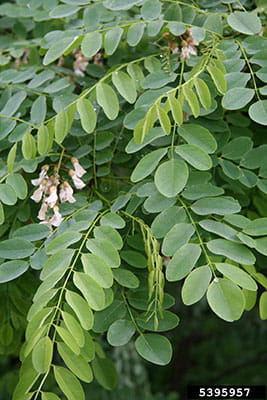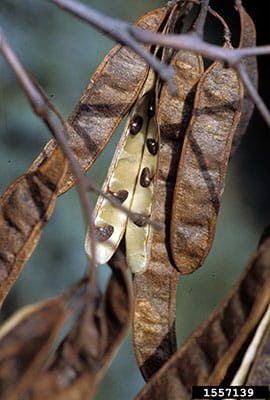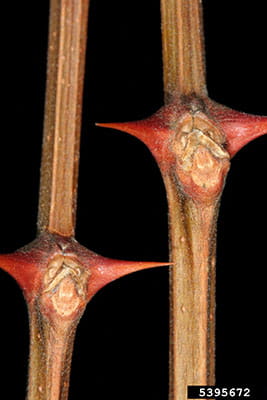The web Browser you are currently using is unsupported, and some features of this site may not work as intended. Please update to a modern browser such as Chrome, Firefox or Edge to experience all features Michigan.gov has to offer.
Invasive Species: Black Locust
Black Locust
(Robinia pseudoacacia)
*Established in Michigan*
IDENTIFICATION
- Fast-growing tree that grows 40-100 feet high.
- Compound leaves have seven to 21 oval leaflets that are dark green on top and light green beneath.
- Fragrant, white flowers hang in elongated clusters, blooming in May and June.
- Black locust seed pods are flat, brown and 3 to 4 inches in length.
- Twigs have ½ inch, paired thorns.
REPORT THIS SPECIES
Use the Midwest Invasive Species Information Network (MISIN) online reporting tool.
- Or - download the MISIN smartphone app and report from your phone.

Photo courtesy of Robert Vidéki, Doronicum Kft., Bugwood.org.

Photo courtesy of Ohio State Weed Lab, The Ohio State University, Bugwood.org.

Photo courtesy of Robert Vidéki, Doronicum Kft., Bugwood.org.
SPECIES INFORMATION
Habitat: This early-successional tree prefers sun and well-drained soils but will populate poor soils and disturbed areas including roadsides, open fields and forest openings.
Native Range: Southeastern United States; on the lower slopes of the Appalachian Mountains, small populations along the slopes and forest edges of southern Illinois, Indiana and Missouri.
U.S. Distribution: Has been planted throughout the Midwest, West Coast and Texas for erosion control, fence posts and fixing nitrogen in the soil.
Local Concern: Black locust spreads by root suckering and stump sprouting, forming dense colonies that shade prairies and forest openings, harming native vegetation. Black locust leaves, stems, bark and seeds are toxic to horses.
MORE INFORMATION
- Black Locust Invasive Species Alert - Printable PDF
- Best Control Practice Guide for Black Locust - This document provides in-depth information about black locust in the state of Michigan including identification, distribution, management and control options.